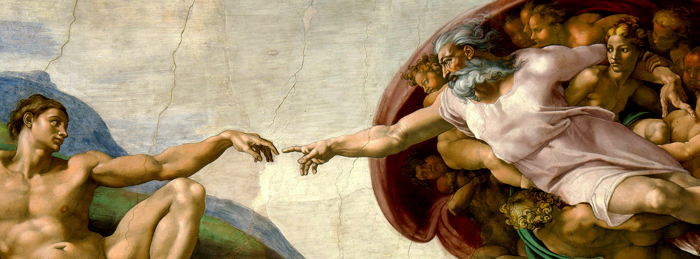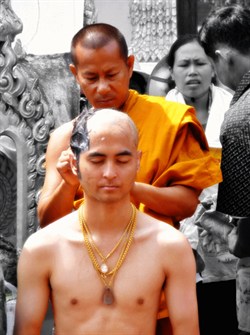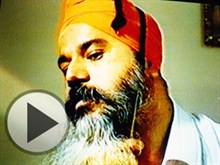
God creating Adam by Michelangelo on the ceiling of the Sistine Chapel
God Forbid: Religious preferences for shaving
God has white hair and a beard. Jesus had a beard and angels are clean shaven. This much we know from hundreds of years of religious representations in Christian art.
And yet, for the first millennium after the death of Jesus there were no representations of God the Father in art. The fourth of the Ten Commandments states that "Thou shalt not make for yourself a carved image, or any likeness of anything that is in heaven above, or that is in the earth beneath, or that is in the water under the earth." And so monks illuminating their manuscripts would, out of fear of both human and divine retribution, depict at the very most, the hand of God reaching down from the sky.
Jesus (God the Son) was a different matter. He had walked among men and so the taboo against his representation was far more easily broken. He was usually shown with a beard in spite of there being no mention of this in the New Testament, though there was a tentative mention of one in the Hebrew version of the Old Testament: "I gave my back to the smiters, and my cheeks to them that plucked off the hair."
Perhaps it is because beards give the impression of age and wisdom, that most religions give their Gods beards. Maybe Jesus grew his during his 'wilderness years' and was never sufficiently image-conscious to shave it off afterwards.
A bearded face can give an air of mystery and piety to the owner. And, by covering the jaw and lips, a beard hides some of the more sensual aspects of the face. Whatever the reason, the connection was made and artists have consistently represented God and his son with a beard and long hair.

From a painting by Fra Angelico in San Marco Museum, Florence -WikiCommons
Religion often requires the opposite from its followers and clergy. For over a thousand years, it was expected that Roman Catholic monks should not only shave their chins but also have tonsures. The Roman, or Saint Peter's, tonsure involved the shaving of the whole head with the exception of a fringe of hair said to represent the crown of thorns.
The sacrifice of having the head shaved combined with the pledge of celibacy commanded the respect of the Catholic laity. The bald pate, was seen by some as a reminder that God could see what was going on inside the head and that monks were symbolically uncovering their head to God's view. A papal canon against priestly beards was made in 1073 and excommunication threatened to those who didn't shave appeared in another decree fifty years later.
The popes followed their own edict until Pope Julius II wore a beard for several months in 1511 as a sign of mourning for the loss of the papal city of Bologna. Pope Clement VII also grew a full beard 15 years later, as a sign of mourning for the ransacking of the papal city of Rome. In fact he kept his beard until his death in 1534. Subsequent popes grew beards until the fashion changed 150 years later.
Gradually, Catholic monks were also allowed to have beards; if they were living in the Levant or in any place where a shaven face was likely to lead to contempt or danger, they could grow a beard for self-protection. Finally, in 1964, Pope Paul VI, issued an edict halting the compulsory keeping of tonsures, meaning that future monks could assimilate themselves more easily into the local community.
Religious rites of passage
In most of the world's religions, shaving, or the lack of it, is an important outward statement for the believer. The two religious shaving extremes are, orthodox Sikhs who don't cut their facial or head hair and most orders of Buddhist monks and nuns, who shave all of their hair off.

A novice has his head shaved in preparation for his ordination into the priesthood of Therevada Buddhism in Uttaradit Province, Thailand ©Tevaprapas Makklay
Buddhism is a religion dating back two and half thousand years with hundreds of millions of followers throughout Asia. Some Buddhist monks and nuns renounce worldly life and join contemplative communities. At the ceremony for their ordination, the shaving of the head is symbolic of rejecting materialism and the decoration and vanity that hair represents.
For the Buddhist clergy, hair represents possibilities for sexual desire as well as being a fashion statement and therefore it's seen as an affectation. The shaving of the head is a humbling experience and the uniformity of baldness reflects the conformity to which all new nuns and monks should aspire. The initial head shaving is a form of baptism, with special prayers for the consecrated hair and a new religious name bestowed on the initiate.
Head shaving is also practised as part of the Hindu religion; it is a rite of passage used to mark the transition from infancy to childhood. Between the age of one and three, an infant's hair is shaved off so that they are symbolically cleansed and ready to start their life as a child. The baby's first hair, grown in the womb, represents their karma from a previous life. Vedic mantras are usually pronounced when the hair is being shaved and finally 'Om' is outlined on the freshly bald head when elders of the family give blessings for the child to have a prosperous and healthy life.
Muslims have a head shaving ceremony called Aqeeqah, as old as the Muslim religion itself. Usually performed a week after a baby is born, a sheep is traditionally sacrificed and the meat distributed to the poor, or used to arrange a feast to which the poor as well as relatives and friends are invited. On the day of Aqeeqah, the child is given a name, their hair is cut off, and the hair weighed - with the equivalent weight traditionally given in silver as 'sadaqah' (charity).
Biggest barber's shop

About a thousand women a day have their hair shorn at the Lord Venkateshwara temple inTirumala ©India Today
The demand for Hindu head shaving has created the world's largest barber shop situated within a sacred temple at Tirumala in Andhra Pradesh, India. Tens of thousands of devotees a day make the pilgrimage to the temple to offer their hair to Lord Venkateshwara, an incarnation of the God Vishnu. Over 100,000 kilograms of hair are shaved off the pilgrims each year and sold on the international market helping to make India the largest exporter of hair.
Men and women, boys and girls come from far and wide to offer their hair. They give this personal contribution to the temple as thanks for, say, the birth of a baby, or a successful harvest. Or they might make a wish for someone's good health or promise to pledge money to the temple if a certain wish is fulfilled. Once they arrive at the temple, the pilgrims are given a token to join a particular queue and an unused razor blade to hand to their barber.
There are up to 600 barbers working at any one time in three shifts throughout the day. The barber takes the blade from the devotee and places it inside a cut throat (straight) razor, soaks their head (no soap) and starts to scrape on the crown of the head. A blessing is given and two to five minutes later, depending on the experience of the barber, the job is done - a girl with waist-length hair will take the same time to be shorn as a short haired man.
The cut hair is gathered up to be sold at auctions at the temple or online to wig and hair extension dealers around the world. The hair is divided into six categories depending on the length and texture: hair longer than 31 inches; 16-30 inches; five to nine inches; less than five and grey hair. Hair from the temple at Tirumala is highly valued on the international hair market, as most of it has never been permed or treated with chemicals. The 100,000 kilograms gathered each year fetches some 2 billion rupees or £23million (at 2013 exchange rate), and the revenue gained by the religious institution (the hair provides a tenth of its revenue) is apparently second only to the Vatican in real terms.
Standing out
 Sikhism is an Indian religion that
started 500 years ago at a time of religious tension between the
country's Muslims and Hindus. In a land of many religions, the
Sikhs soon came to stand out by their devotees refusal to cut
neither head nor beard hair. The reason for his hirsute approach is
that the Sikhs believe that what God has given to Man is sacred and
should be respected as such and not be removed. Sikhism also
demands that all male followers carry the name 'Singh' meaning
'Lion' and the beard of the lion is seen as representing its
strength.
Sikhism is an Indian religion that
started 500 years ago at a time of religious tension between the
country's Muslims and Hindus. In a land of many religions, the
Sikhs soon came to stand out by their devotees refusal to cut
neither head nor beard hair. The reason for his hirsute approach is
that the Sikhs believe that what God has given to Man is sacred and
should be respected as such and not be removed. Sikhism also
demands that all male followers carry the name 'Singh' meaning
'Lion' and the beard of the lion is seen as representing its
strength.
In the 18th century, the Sikhs were undergoing their worst period of persecution in the Punjab by the Mughals. In a period of religious cleansing, hundreds of Sikhs were executed a week. The Sikhs, before execution, were offered a reprieve if they cut their hair and recanted their faith. Most refused. Thousands of Sikh martyrs were created at this time and the deep significance of uncut hair was established.
Today, a male Sikh who has kept his beard will take about five minutes preparing his hair and beard in the morning (play film alongside to see how). First, he will comb and gather his head hair into a single mane, knot it on top of his head and fix it in position with a small comb. Then he will put on the small 'under turban', tie a cord over this turban and under his chin and then fold his beard under the cord. He will then apply a fixative on the folded beard so that it stays in place. The last touch is the placing of the distinctive outer turban.
